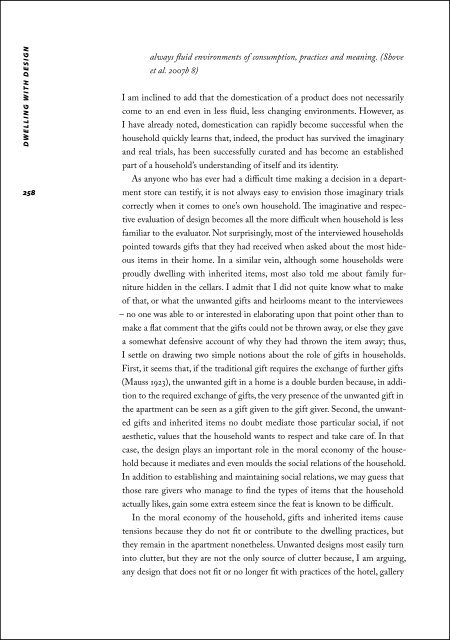Lataa ilmaiseksi
Lataa ilmaiseksi
Lataa ilmaiseksi
You also want an ePaper? Increase the reach of your titles
YUMPU automatically turns print PDFs into web optimized ePapers that Google loves.
D W E L L I N G W I T H D E S I G N<br />
258<br />
always fluid environments of consumption, practices and meaning. (Shove<br />
et al. 2007b 8)<br />
I am inclined to add that the domestication of a product does not necessarily<br />
come to an end even in less fluid, less changing environments. However, as<br />
I have already noted, domestication can rapidly become successful when the<br />
household quickly learns that, indeed, the product has survived the imaginary<br />
and real trials, has been successfully curated and has become an established<br />
part of a household’s understanding of itself and its identity.<br />
As anyone who has ever had a difficult time making a decision in a department<br />
store can testify, it is not always easy to envision those imaginary trials<br />
correctly when it comes to one’s own household. The imaginative and respective<br />
evaluation of design becomes all the more difficult when household is less<br />
familiar to the evaluator. Not surprisingly, most of the interviewed households<br />
pointed towards gifts that they had received when asked about the most hideous<br />
items in their home. In a similar vein, although some households were<br />
proudly dwelling with inherited items, most also told me about family furniture<br />
hidden in the cellars. I admit that I did not quite know what to make<br />
of that, or what the unwanted gifts and heirlooms meant to the interviewees<br />
– no one was able to or interested in elaborating upon that point other than to<br />
make a flat comment that the gifts could not be thrown away, or else they gave<br />
a somewhat defensive account of why they had thrown the item away; thus,<br />
I settle on drawing two simple notions about the role of gifts in households.<br />
First, it seems that, if the traditional gift requires the exchange of further gifts<br />
(Mauss 1923), the unwanted gift in a home is a double burden because, in addition<br />
to the required exchange of gifts, the very presence of the unwanted gift in<br />
the apartment can be seen as a gift given to the gift giver. Second, the unwanted<br />
gifts and inherited items no doubt mediate those particular social, if not<br />
aesthetic, values that the household wants to respect and take care of. In that<br />
case, the design plays an important role in the moral economy of the household<br />
because it mediates and even moulds the social relations of the household.<br />
In addition to establishing and maintaining social relations, we may guess that<br />
those rare givers who manage to find the types of items that the household<br />
actually likes, gain some extra esteem since the feat is known to be difficult.<br />
In the moral economy of the household, gifts and inherited items cause<br />
tensions because they do not fit or contribute to the dwelling practices, but<br />
they remain in the apartment nonetheless. Unwanted designs most easily turn<br />
into clutter, but they are not the only source of clutter because, I am arguing,<br />
any design that does not fit or no longer fit with practices of the hotel, gallery
















